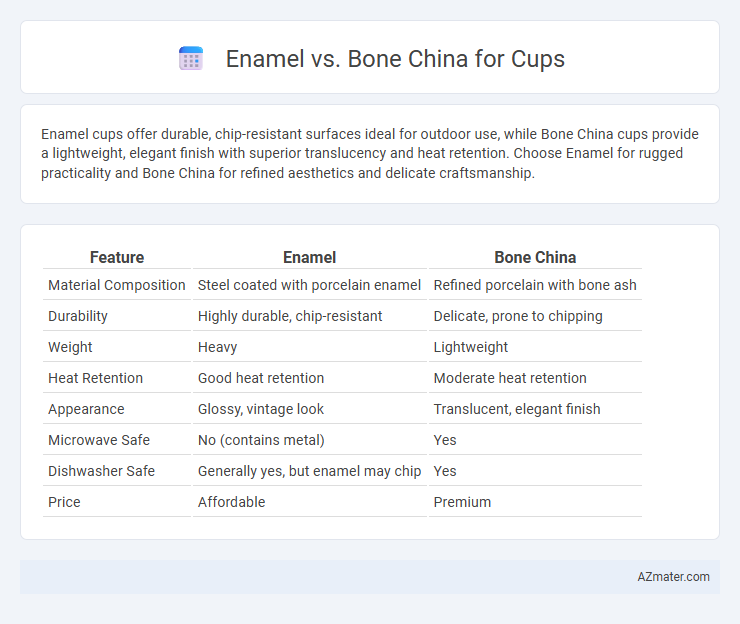Enamel cups offer durable, chip-resistant surfaces ideal for outdoor use, while Bone China cups provide a lightweight, elegant finish with superior translucency and heat retention. Choose Enamel for rugged practicality and Bone China for refined aesthetics and delicate craftsmanship.
Table of Comparison
| Feature | Enamel | Bone China |
|---|---|---|
| Material Composition | Steel coated with porcelain enamel | Refined porcelain with bone ash |
| Durability | Highly durable, chip-resistant | Delicate, prone to chipping |
| Weight | Heavy | Lightweight |
| Heat Retention | Good heat retention | Moderate heat retention |
| Appearance | Glossy, vintage look | Translucent, elegant finish |
| Microwave Safe | No (contains metal) | Yes |
| Dishwasher Safe | Generally yes, but enamel may chip | Yes |
| Price | Affordable | Premium |
Introduction to Enamel and Bone China
Enamel cups, made from metal coated with a durable layer of vitreous enamel, offer exceptional heat resistance and a lightweight yet sturdy design ideal for outdoor and everyday use. Bone china is a type of porcelain composed of bone ash, feldspathic material, and kaolin, prized for its high levels of whiteness, translucency, and strength despite its delicate appearance. Both materials cater to different needs, with enamel excelling in durability and portability, while bone china is favored for elegance and refined aesthetics in tableware.
Materials and Composition Comparison
Enamel cups are crafted from metal coated with a layer of vitreous enamel made of powdered glass fused onto the surface, providing durability and resistance to chipping. Bone china contains a mixture of bone ash (typically 30-45%), kaolin, and feldspar, resulting in a lightweight, translucent ceramic renowned for its strength and delicate appearance. The key difference lies in enamel's metal base with glass coating, offering toughness and heat retention, while bone china's mineral composition gives it elegance and thermal insulating properties.
Manufacturing Process Differences
Enamel cups are produced by fusing powdered glass to a metal base, typically steel or iron, through high-temperature firing, creating a durable, non-porous surface resistant to chipping and corrosion. Bone china manufacturing involves mixing bone ash, feldspar, and kaolin, then firing the blend at high temperatures to create a translucent, lightweight ceramic known for its strength and delicate appearance. The primary manufacturing difference lies in enamel's metal substrate coated with glass versus bone china's fully ceramic composition derived from a unique combination of bone ash and clay minerals.
Durability and Strength
Enamel cups, made from steel coated with enamel, offer exceptional durability and resistance to chipping and cracking, making them ideal for outdoor use and rough handling. Bone china, composed of bone ash, feldspar, and kaolin, provides a delicate yet strong structure, being more resistant to breakage than standard porcelain but less impact-resistant compared to enamel. When prioritizing strength and long-term durability, enamel cups outperform bone china in withstanding drops and heavy use, while bone china excels in lightweight elegance with moderate toughness.
Heat Retention and Safety
Bone china cups excel in heat retention due to their dense, vitrified composition that maintains beverage temperature longer, enhancing the drinking experience. Enamel cups, made from metal coated with porcelain, conduct heat quickly, causing the cup surface to become hot and potentially unsafe to hold without protection. Bone china is safer for hot drinks as it insulates heat better, reducing the risk of burns while enamel cups require caution due to rapid heat transfer.
Aesthetic Appeal and Design Options
Enamel cups showcase a rustic, vintage aesthetic with vibrant, glossy finishes that suit casual and outdoor settings, while bone china cups offer a refined, elegant appearance featuring delicate translucency and intricate patterns ideal for formal occasions. Enamel's design options include bold colors and simple motifs with a durable steel core, whereas bone china provides an extensive range of hand-painted details, gilded accents, and classic floral designs. The choice between enamel and bone china cups ultimately depends on the desired style, with enamel emphasizing rugged charm and bone china epitomizing sophisticated craftsmanship.
Weight and Handling
Enamel cups are significantly lighter than bone china cups, making them easier to handle and ideal for outdoor use or travel. Bone china is denser and heavier, offering a more substantial feel but requiring careful handling to avoid chipping. The lightweight durability of enamel contrasts with the delicate elegance of bone china, influencing user preference based on portability and fragility.
Maintenance and Cleaning
Enamel cups are highly durable and resistant to chipping, making them easy to clean with just warm soapy water and a soft sponge, but they can discolor if exposed to harsh detergents or abrasive materials. Bone china cups require gentle handling and should be washed by hand using mild detergent to preserve their delicate translucent surface and prevent fine cracks or crazing. While enamel is dishwasher safe, bone china often benefits from air drying to maintain its pristine finish and avoid stress from extreme temperature changes.
Price and Value Considerations
Enamel cups are typically more affordable and durable, making them an excellent choice for everyday use, especially in outdoor or casual settings. Bone china cups, while pricier, offer superior elegance, translucency, and a lightweight feel, providing greater value for formal occasions or collectors seeking fine craftsmanship. Evaluating the price against intended use and maintenance needs helps determine the best investment between the sturdy enamel and the luxurious bone china cups.
Choosing the Right Cup for Your Needs
Enamel cups offer durability and lightweight design, making them ideal for outdoor activities and casual use, while bone china cups provide a delicate, elegant finish suited for formal settings and special occasions. Bone china's high strength and translucency come from its unique composition of bone ash, giving it a refined aesthetic unmatched by enamel. Selecting the right cup depends on whether durability and practicality or sophistication and visual appeal are your primary requirements.

Infographic: Enamel vs Bone China for Cup
 azmater.com
azmater.com